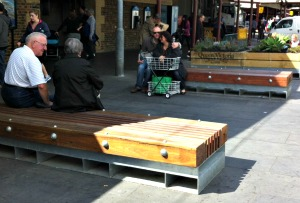Footpaths

Footpaths might seem elementary to providing for walking, but they can't be taken for granted. An RACV study of bus stops in outer Melbourne found more than 1,600 (18%) were not connected to the footpath network (Connect Outer Melbourne Footpaths).
Footpaths facilitate two primary groups of activities; moving activities and stationary activities. Good footpath design with suitable materials and furniture can successfully cater for both.
The Western Australia DOT pedestrian guidelines set out the fundamental pedestrian infrastucture requirements. It states that footpaths should provide a firm, even, slip resistant surface in both wet and dry conditions. The increasing age of the population and the increased reliance on mobility devices emphasises the need for firm even paving surfaces rather than alternatives such as slate or cobblestone. Section 4.9.10 of the Vic Roads Traffic Engineering Manual, contains comprehensive guidance on footpath provision.
Continuous footpath connections are critical to facilitate walking by children, parents, seniors and others with limited mobility. Pram ramps are essential for road crossing.
Footpath crowding
A certain level of crowding makes a street lively, inviting and vibrant. However there is a level at which crowding goes beyond the point of acceptability and creates an uncomfortable environment that does not facilitate the needs of all users of the footpath. In a Victorian context crowding can be an issue in the CBD, at shopping strips, schools or universities and public transport nodes.
Pedestrian level of service classifies the level of comfort based on the level of crowding a pedestrian experiences on the street or at key areas such as a crossings.The Transport for London Pedestrian Comfort Guidence is a comprehensive resource for assessing methodologies for pedestrian comfort.
Street Furniture
 Seating in character - Victoria Market, Melbourne
Seating in character - Victoria Market, Melbourne
Street furniture is an essential part of the urban fabric for pedestrians, it has the power to enhance and create a place where pedestrians choose to spend their time. The NZ transport agency comprehensively deals with street furniture in their Pedestrian Planning Guide (Section 14.9). Footpaths in activity centres are generally busy spaces with many competing uses, and careful positioning of street furniture is important to avoid clutter. In areas of heavy pedestrian use, such as retail areas, it is especially important to provide street furniture that supports and encourages walking, as pedestrians value the opportunity to sit, rest and relax during shoopings trips when they are laden with bags.
Pedestrians should be provided with access to fresh drinking water, information signage, public toilets, rubbish bins, shelters for public transport, and most importantly opportunities to sit and enjoy the space. People like to observe other people therefore the seats should be placed so that they look onto areas of human activity.
The South Australia Streets for People Compendium is a comprehensive holistic report which addresses the finer details of good practice for people friendly streets.
Public art

Public art can be used to emphasise distinct local character, promote an event or highlight an issue. Public art possesses the ability to build social connections, strengthen social inclusion and foster community development. Public art can be used in three forms; permanent, temporary or installation.
Street art can also be a spontaneous, community driven feature of great streets. Councils should facilitate and encourage community street art. A good example is the colourful pavers of Union Street, Westgarth.
Lighting
 Example of good quality seating and non-intrusive lighting
Example of good quality seating and non-intrusive lighting
Lighting has a significant impact on orientation, security and visual quality at night. Good lighting on footpaths, facades, niches and corners is essential along pedestrian routes to strengthen the sense of security.
The Project for Public Space suggest that too much lighting can be as bad as too little lighting, so alternative non intrusive forms of lighting, such as art as lighting, should be provided. Shuttering on shop windows should also be discouraged as the spill over light from shop fronts helps illuminate the street and increase the feeling of security.
Toilets
There is no statutory requirement in Victoria for councils to provide public toilets, however access to toilet facilities is important to pedestrian comfort, especially for seniors and parents with children. The City of Melbourne found in a survey that 90% of people of people believed it was extremely or very important to provide public toilets.
The National Toilet Map enables people to locate toilets across the country.